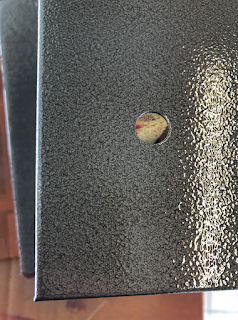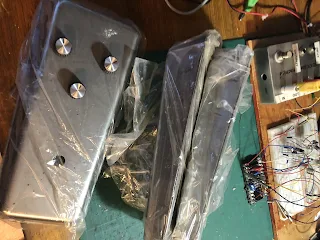Vintage fuzz, guitars, amps, guitar effects and other things that make noise.
Thursday, December 31, 2020
Wednesday, December 30, 2020
BALDWIN-BURNS: Buzzaround, Tag Board Layout
This is my slightly more spacious take on the original tagboard layout for the Baldwin-Burns Buzzaround. Same size board and the same layout; it's just spread out a bit more to take advantage of all the lugs available.
BALDWIN-BURNS BUZZAROUND - TAGBOARD LAYOUT
Tuesday, December 29, 2020
JOHN HORNBY SKEWES: Zonk Machine
The Hornby Skewes Zonk Machine is pretty much a MKI Tone Bender with some value changes - most notably the 1n capacitor on the input and resistors to collectors.
A classic guitar effect from back in the day.
HORNBY SKEWES ZONK MACHINE - ORIGINAL TAG BOARD LAYOUT
TAG BOARD LAYOUT
Wednesday, December 23, 2020
WEDGE ENCLOSURE: Finishing Enclosure #1, Dark Grey Hammerite
I bought a couple of these enclosures on e-bay, not being completely sure what they would be like, but I'm pretty happy with them. They feel solid, and the tolerances are good (no big gaps, and everything fits nicely). The corners are a bit sharp, but nothing a file can't sort out before finishing.
VINTAGE-STYLE WEDGE ENCLOSURE DIMENSIONS
DRILLING THE ENCLOSURE
PAINT - HAMMERED FINISH
APPLYING GRAPHICS ON THE ENCLOSURE - WATERSLIDE DECAL
FINAL CLEARCOAT COVER
FINISHED ENCLOSURE WITH HARDWARE
Friday, December 18, 2020
Wednesday, December 16, 2020
TONE BENDER ENCLOSURE: Finishing Enclosure, Yellow
Finally found a few vintage-style enclosures for some Tone Bender MKIII / MKIV circuits that I’ve built and had sitting around waiting for the right enclosure. Can’t wait to clean these up and get them up and running - currently wrapped in plastic and covered in oil, as they are raw steel after all.
I'll try and document my success and/or failures finishing these (I've never done steel before). Thinking of running with a polish and clear coat on one, and maybe a bit of bright colour on the other two.
Here's the finished product - it's D*A*M Fuzz Sound MKIII. I like yellow so much I made two.
ROTOSOUND FUZZ / VOX STYLE TONE BENDER ENCLOSURES
STEPS FOR PAINTING THE ENCLOSURE
- wash in hot water with detergent to remove oil (dry it very quickly to avoid rust)
- sand with 400 grit wet and dry, followed by 800 and finally 1200 (in the same direction)
- wash again in hot water with detergent, then wipe down with paper towels and isopropyl alcohol (again, don't waste time, or this will rust before your eyes)
- apply two coats on one side, wait an hour, then on the other side. Repeat.
Saturday, December 12, 2020
D*A*M: Fuzzrong FR-70, Schematic
D*A*M: Fuzzrong FR-70, 0.15" Vero Layout
Unlike the D*A*M Fuzzrong FR-69, which is very much a straight germanium Fuzzrite, the D*A*M Fuzzrong FR-70 is a little different.
It's a version of the Rosac Nu-Fuzz, which was designed by Ed Sanner, the designer of the Fuzzrite. There are a some changes with component values, but you are basically looking at the bones of Nu-Fuzz.
It uses very common transistors - so there is no hunting for expensive/rare germanium only to find out they sound 95% like the ones you already have...
D*A*M FUZZRONG FR-70 - VERO LAYOUT (ORIGINAL D*A*M LAYOUT)
NU-FUZZ vs FR-70
Thursday, December 10, 2020
D*A*M: FUZZrong FR-69
This is the layout that D*A*M used for the Fuzzrong FZ-69, which is essentially a germanium Fuzzrite.
I couldn't make out the pot values or the 2n2 cap values on the photos I could find, so will have to take this at face value.
D*A*M FUZZRONG FR-69 - VERO LAYOUT
Wednesday, December 9, 2020
D*A*M: Buzzotron, Schematic
D*A*M BUZZOTRON - EARLIER VERSION SCHEMATIC
D*A*M BUZZOTRON - LATER VERSION SCHEMATIC
Monday, December 7, 2020
MARSHALL: SupaFuzz, 0.15" Vero Layout
This is the original 1968 0.15" vero layout for the Marshall SupaFuzz (which may be disputed by some).
The cuts may not be in the exact positions as the original, but no matter... same with Filter pin 3 connection. This may be on the other side of the board, but that makes no real difference. I have not included shielding, but that's easy enough to work out from the photo.
MARSHALL SUPAFUZZ - VERO LAYOUT
Sunday, December 6, 2020
PARK: Fuzz Sound, Schematic
ELKA: Dizzy Tone, Schematic
Saturday, December 5, 2020
Saturday, November 28, 2020
D*A*M: Tone Bender TB-00, 0.15" Vero Layout
The D*A*M TB-00 Tone Bender is Vox Tone Bender with a minor variation on the original.
Strangely the input capacitor on this layout is hidden under the board, so I guessed the value. Likely to be the same as the original (150n) or a 220n like the '66. No idea why it's hidden - some were under the board on originals, so maybe that's why?
Anyways, had me confused for a while trying to work out what was going on while working on the layout.

















































